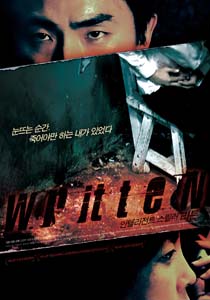Written (2007)
10th April 2010
 When I had first read a discription of this film while it was in production, I thought that it sounded interesting but I knew I probably would not have the chance to see it as it was definitely what people would call ‘arthouse’. Arthouse films rarely get wide releases. When it was released on DVD earlier this year, I bought it without hesitation. Last week, I finally got around to watching it. Now, when an arthouse film is made poorly, it can come off as either pretentious–screaming ‘Look at me! I am ART’ or boring and unwatchable. When done correctly, this type of film is thought provoking, intelligent and enjoyable. I am very happy to report that Written falls under the latter classification. But be warned, this is not a film that you just pop into the DVD player and turn off your mind. The story requires your full attention to follow as the reality inside the film rapidly changes. If you take a moment to answer the phone, you’re going to miss something important and be confused for the rest of the movie.
When I had first read a discription of this film while it was in production, I thought that it sounded interesting but I knew I probably would not have the chance to see it as it was definitely what people would call ‘arthouse’. Arthouse films rarely get wide releases. When it was released on DVD earlier this year, I bought it without hesitation. Last week, I finally got around to watching it. Now, when an arthouse film is made poorly, it can come off as either pretentious–screaming ‘Look at me! I am ART’ or boring and unwatchable. When done correctly, this type of film is thought provoking, intelligent and enjoyable. I am very happy to report that Written falls under the latter classification. But be warned, this is not a film that you just pop into the DVD player and turn off your mind. The story requires your full attention to follow as the reality inside the film rapidly changes. If you take a moment to answer the phone, you’re going to miss something important and be confused for the rest of the movie.
The film opens with an unnamed man waking up in a bathtub of ice water, hooked up to an IV with a surgical scar across his belly. He quickly realizes through his pain that his kidney has been stolen while he was unconcious. Ignoring the writing on the wall that states in English ‘Go to the Hospital’, he begins a bizarre quest to find his kidney. Even he recognizes this as irrational–it is not like he can put it back in–but he is driven forward.
Another reality, this one filmed in sepia tones. A movie director is explaining to a producer about the plot of a film he is making and it mimics the actions of what we have just seen. The director’s only complaint with his story is the way the writer is working. She is too slow–giving the actors the script on a day-by-day basis. The actors do not care for this style as they have no time to practice their lines. The director is annoyed because the writer wants to change the ending from her original idea.
The writer, it turns out, is concerned about the character she created to the point of obsession. She feels guilt because, as she wrote him, his suffering never ends–it is what drives the story. Also, as she sees it, his pain will be eternal as the film is made. Even though he is slated to die at the end, it will always restart with him waking confused in the bathtub—unless she can somehow change the ending. To this end, she writes herself into the story and gives him a copy of the script to convince him that his reality is not the only one and he must somehow escape his destiny and gain free will. However, things will become even more complex as a third reality begins to encroach.
As the movie is being made, the actor literally puts himself into the story–studying the character every chance he gets. His ultimate goal is to pick the main character apart so he can understand him completely and ultimately become him. At one point the actor boasts that he has already ‘killed’ dozens of characters as he conquers them body and soul. Of course, in reality this is not really killing, but it will prove fatal to the main character who might cease to exist if the actor gets his way. It seems as if the actor has all the advantages as he can leave the world of story/film anytime he wants while the main character finds that he cannot cross over into reality. He is stuck in the story and slowly becomes endangered by the approaching film.
The overall atmosphere of the film reminded me a little of Naked Lunch (1991). It can be confusing at times, but if you pay attention and put some thought into it, you will be rewarded. The movie was only 87 minutes long–I wish it were longer. I loved this movie and highly recommend it.
